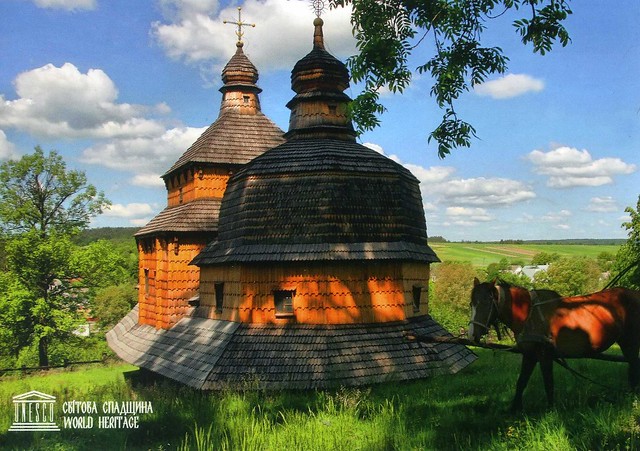I received a few Ukrainian Unesco cards in an envelope a while back, this is one of them, one of the Wooden Tserkvas of the Carpathian Region in Poland and Ukraine.
Located at the eastern fringes of Central Europe within the Polish and Ukrainian Carpathian mountain range, the sixteen wooden tserkvas (churches) are outstanding examples of the once widespread Orthodox ecclesiastical timber-building tradition in the Slavic countries that survives to this day. The architectural forms of the tserkvas with tri-partite plans, pyramidal domes, cupolas and bell towers conform to the requirements of Eastern liturgy while reflecting the cultural traditions of the local communities that developed separately due to the mountainous terrain. They include Hutsul types in the Ukrainian south-eastern Carpathians at Nyzhniy Verbizh and Yasynia; Halych types in the northern Carpathians either side of the Polish/Ukrainian border at Rohatyn, Drohobych, Zhovkva, Potelych, Radruż and Chotyniec; Boyko types either side of the Polish/Ukrainian border near the border with Slovakia at Smolnik, Uzhok and Matkiv, and western Lemko types in the Polish west Carpathians at Powroźnik, Brunary Wyźne, Owczary, Kwiatoń and Turzańsk. Built using the horizontal log technique with complex corner jointing, and exhibiting exceptional carpentry skills and structural solutions, the tserkvas were raised on wooden sills placed on stone foundations, with wooden shingles covering roofs and walls. The tserkvas with their associated graveyards and sometimes free-standing bell towers are bounded by perimeter walls or fences and gates, surrounded by trees.
Subscribe to:
Post Comments (Atom)





 Maroon
Maroon 










































































































































































No comments:
Post a Comment